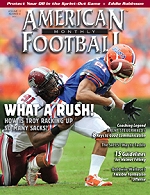Article CategoriesAFM Magazine
|
Getting the Perfect Fit – 15 steps for finding the right helmet to help keep your players safe.by: AFM Editorial Staff© More from this issue The proper fitting of helmets can be a time-consuming process. However, it’s a critical element in protecting players’ safety. Helmets need to be “issued and fit,” not merely handed out. Schedule and allow time for this very integral part of your program. Don’t shortchange your athletes, especially when it comes to safety. Proper fit is the key to head protection and player comfort. The goal is a customized fit for every player. A helmet that doesn’t fit properly will still provide protection, but may contribute to head injuries by shifting and exposing vulnerable areas that must be protected. The helmet should move with the head, or move as the head moves, in the same direction and at the same speed. The helmet should not move independently of the head. The helmet shell, internal components an....The full article can only be seen by subscribers.
|
|
|||||||
| HOME |
MAGAZINE |
SUBSCRIBE | ONLINE COLUMNISTS | COACHING VIDEOS |
Copyright 2025, AmericanFootballMonthly.com
All Rights Reserved





